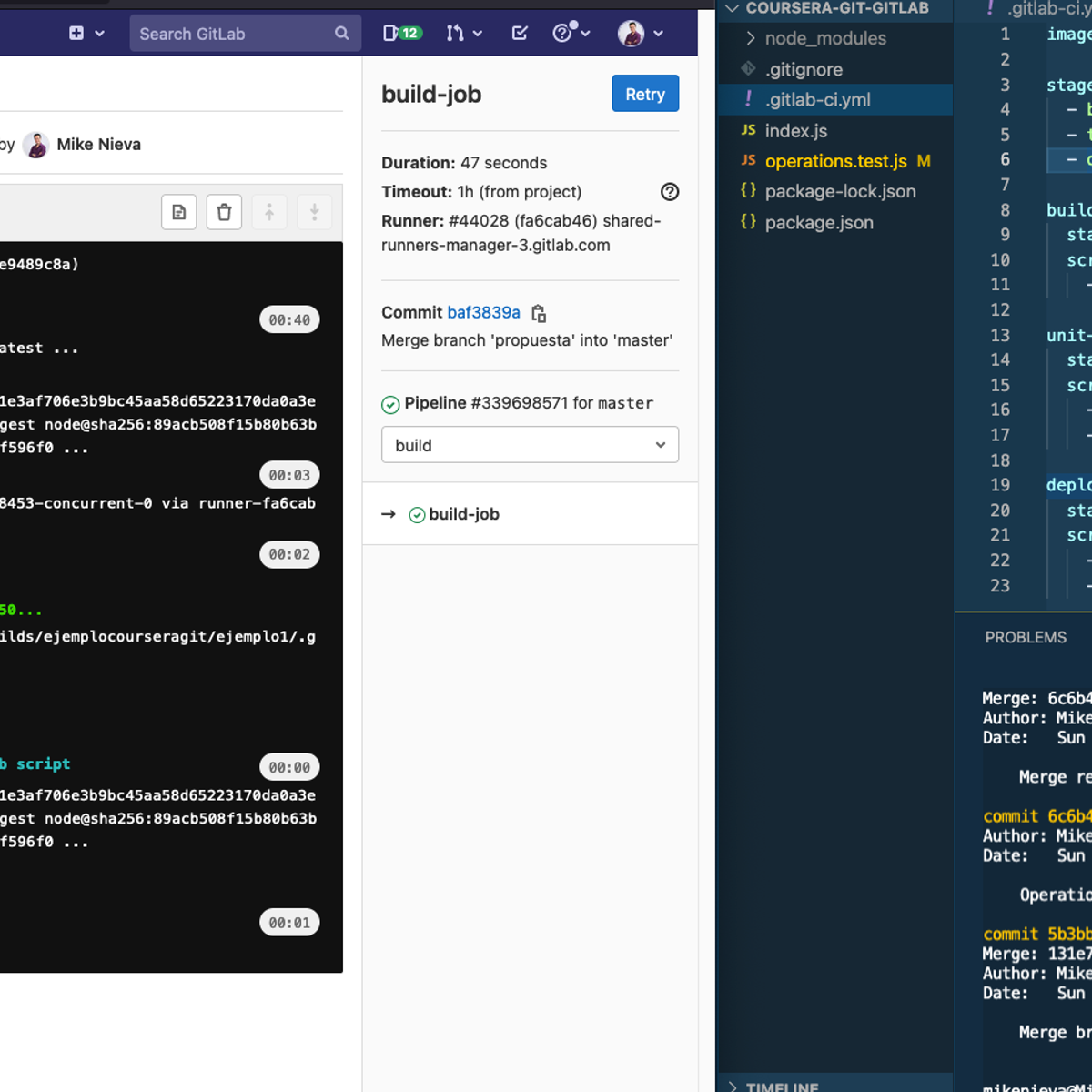
En este curso basado en un proyecto y de 1 hora de duración, aprenderás a:
- Trabajar con los comandos esenciales de Git
- Crear un flujo de trabajo con Git y GitLab
- Desarrollar un proceso de integración contínua básico
What's inside
Syllabus
Good to know
Save this course
Activities
Revise Git version control
Show steps
Reinforces foundational understanding of Git before beginning the course.
Browse courses on
Git
Show steps
-
Review the Git documentation
-
Use online tutorials to practice Git commands
Practice Git commands on personal projects
Show steps
Provides hands-on experience using Git commands in a real-world context.
Browse courses on
Git
Show steps
-
Clone a Git repository
-
Create a new branch
-
Edit and commit changes
-
Merge changes
Follow tutorials on GitLab workflow
Show steps
Enhances understanding of the GitLab workflow and its integration with Git.
Browse courses on
GitLab
Show steps
-
Find tutorials on GitLab
-
Follow the steps in the tutorials
Five other activities
Expand to see all activities and additional details
Show all eight activities
Create a cheat sheet of common Git commands
Show steps
Solidifies understanding of Git commands and provides a quick reference.
Browse courses on
Git
Show steps
-
List common Git commands
-
Describe the purpose and usage of each command
-
Organize the commands into a cheat sheet
Attend a workshop on Git and continuous integration
Show steps
Provides expert insights and practical experience in using Git for continuous integration.
Browse courses on
Git
Show steps
-
Find a workshop on Git and continuous integration
-
Attend the workshop
Develop a simple continuous integration pipeline
Show steps
Reinforces understanding of continuous integration by creating a real-world pipeline.
Browse courses on
Continuous Integration
Show steps
-
Define the build process
-
Configure the continuous integration tool
-
Test the pipeline
Mentor junior developers on Git and version control
Show steps
Strengthens understanding by explaining concepts to others and providing guidance.
Browse courses on
Git
Show steps
-
Find junior developers who need guidance on Git
-
Provide mentorship and support
Seek mentorship from experienced Git users
Show steps
Provides opportunities for additional guidance and insights from experts.
Browse courses on
Git
Show steps
-
Identify experienced Git users
-
Reach out and request mentorship
Revise Git version control
Show steps
Reinforces foundational understanding of Git before beginning the course.
Browse courses on
Git
Show steps
- Review the Git documentation
- Use online tutorials to practice Git commands
Practice Git commands on personal projects
Show steps
Provides hands-on experience using Git commands in a real-world context.
Browse courses on
Git
Show steps
- Clone a Git repository
- Create a new branch
- Edit and commit changes
- Merge changes
Follow tutorials on GitLab workflow
Show steps
Enhances understanding of the GitLab workflow and its integration with Git.
Browse courses on
GitLab
Show steps
- Find tutorials on GitLab
- Follow the steps in the tutorials
Create a cheat sheet of common Git commands
Show steps
Solidifies understanding of Git commands and provides a quick reference.
Browse courses on
Git
Show steps
- List common Git commands
- Describe the purpose and usage of each command
- Organize the commands into a cheat sheet
Attend a workshop on Git and continuous integration
Show steps
Provides expert insights and practical experience in using Git for continuous integration.
Browse courses on
Git
Show steps
- Find a workshop on Git and continuous integration
- Attend the workshop
Develop a simple continuous integration pipeline
Show steps
Reinforces understanding of continuous integration by creating a real-world pipeline.
Browse courses on
Continuous Integration
Show steps
- Define the build process
- Configure the continuous integration tool
- Test the pipeline
Mentor junior developers on Git and version control
Show steps
Strengthens understanding by explaining concepts to others and providing guidance.
Browse courses on
Git
Show steps
- Find junior developers who need guidance on Git
- Provide mentorship and support
Seek mentorship from experienced Git users
Show steps
Provides opportunities for additional guidance and insights from experts.
Browse courses on
Git
Show steps
- Identify experienced Git users
- Reach out and request mentorship
Career center
DevOps Engineer
Software Architect
Information Security Analyst
Software Engineer
Cloud Architect
Project Manager
Business Analyst
Quality Assurance Analyst
Data Architect
User Experience Designer
Technical Writer
Machine Learning Engineer
Data Analyst
Product Manager
Front-End Developer
Reading list
Share
Similar courses
OpenCourser helps millions of learners each year. People visit us to learn workspace skills, ace their exams, and nurture their curiosity.
Our extensive catalog contains over 50,000 courses and twice as many books. Browse by search, by topic, or even by career interests. We'll match you to the right resources quickly.
Find this site helpful? Tell a friend about us.
We're supported by our community of learners. When you purchase or subscribe to courses and programs or purchase books, we may earn a commission from our partners.
Your purchases help us maintain our catalog and keep our servers humming without ads.
Thank you for supporting OpenCourser.



